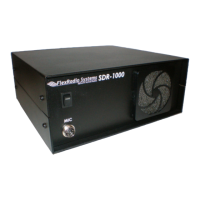TM
FlexRadio Systems 2003 Page 2
Probable Causes:
1. Cable is too long – Use the shortest 25 conductor parallel port cable you can find.
Under no circumstance should it be longer than 6 feet (1.8m) and less is
preferable. The cable should also be shielded. Caution: most flat cables do not
work in this application.
2. Parallel port drive insufficient – In some cases, the parallel port itself may be at
fault on some of the clone chips. Check the DC voltage on the parallel port data
lines (X1-1 to X1-9). Active high lines should be at +5VDC potential. Low
voltage drive can cause erroneous data to be sent to the DDS so that it looses it
synchronization. Try a different computer or add a new parallel port card to your
system.
Note: If the DDS is running properly, the radio will draw just under 700mA (400mA
with the switching regulator at IC5) in receive mode depending on the frequency of
operation. With the RFE board installed, current drain will be just over 800mA. A very
low current could mean that the DDS is not running. A high current, near 1A or more
typically means that the radio is not being reset properly.
The Radio Resets but I Don’t Hear Any Signals
Operational Description: The SDR-Console uses the Windows Multimedia Mixer to
control the baseband audio input and output from and to the SDR-1000 respectively. The
mixer controls may be accessed by double clicking on the speaker icon in the Windows
system tray or through the Windows Control Panel. There are two control panels:
normally called Volume (or Playback) Control and Recording Control. The SDR-
Console uses the Recording Control to input signals through the Line In and Microphone
connectors on the sound card. It then processes the signals and sends the output to the
Wave control on the Volume Control panel.
Controls on the Volume Control panel connect sounds directly from their respective
inputs to the Speaker output Destination through the Wave Output control. This means
that signals originating from this control panel cannot be heard or processed by the SDR-
Console software. They are passed directly though by the operating system to the
Speaker/Line outputs. The Speaker/Line output is used by the SDR-1000 as baseband
transmit signal and therefore any signal coming through the Volume Control panel will
be placed directly on the air in unfiltered, double sideband suppressed carrier mode. For
this reason it is important that all controls on the Volume Control panel be muted except
for the Wave and Master Volume controls. If the Line In and Microphone controls are
not muted here, they will cause an echo effect on receive or transmit audio respectively.
Controls on the Record Control panel route signals to the Wave Input Destination, which
is used by the SDR-Console software to capture the incoming digitized signals. These
signals are processed and routed to the Wave Output control on the Volume Control
panel to be sent to the Speaker Destination. This is true for both receive and transmit
modes. The only difference is that the Record Control Source is switched between the

